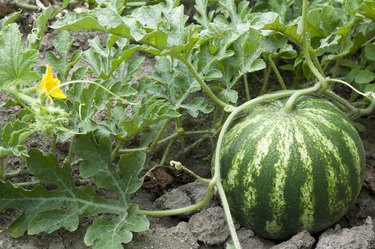
Synonymous with summer, watermelons (Citrullus lanatus) consist of more than 90 percent water, hence their name. It is therefore no surprise that proper watering is one of the keys to harvesting sweet, delicious watermelons from the home garden. Watermelons are hardy in U.S. Department of Agriculture zones 2 to 11; however, they are grown as annuals.
Growing Watermelons at Home
Video of the Day
Watermelons are warm-season fruits that grow best when temperatures are between 70 and 85 degrees Fahrenheit. Watermelons also need warm soil. While you can sow watermelon seeds directly into the soil, if you live in a cooler climate, you will likely need to start your watermelon plants indoors and transplant them outside once soil temperatures reach 65 degrees Fahrenheit. Plant watermelons in a spot where they will receive at least six hours of sun a day, which is considered full sun.
Video of the Day
Watermelon companion plants include radishes and tansy, which may help to prevent pesky cucumber beetles from feeding on your watermelons. Also consider cowpeas and buckwheat, which attract beneficial insects that keep watermelon pests at bay. Planting watermelons alongside herbs like oregano and thyme will help attract pollinators to your patch. Watermelons are large fruits, so be sure to give them plenty of space whether you are planting them alone or alongside other crops.
Tips for Watering Watermelons
Because watermelons have such a high moisture content, it is essential to water the plants properly, especially during fruit set and throughout the fruits' development. Watermelons need approximately an inch or two of water a week. You want to thoroughly soak the root zone, which is usually about 12 inches deep. Be careful not to overwater your watermelons, however, which causes necessary nutrients to leach out of the soil.
Because wet leaves can become a breeding ground for a host of diseases, you should be sure to only water the root zone of your watermelon plants. In fact, drip irrigation is highly recommended when growing watermelons. To help retain moisture, you can apply mulch around the plant once the vines are between 6 and 8 inches. To harvest the best-tasting fruit, reduce watering when watermelons start to ripen. If you overwater the melons during their last two weeks of development, the fruit might split open.
Types of Melons
Watermelons are divided into three categories: early season, main season or seedless. Early season melons usually ripen in 70 to 75 days and are small in size, which is why they are often referred to as "icebox melons." Main-season watermelons are much bigger, often weighing over 20 pounds, and they can take as many as 90 days to ripen.
Seedless watermelons are genetically engineered hybrids that take just as long as main-season watermelons to ripen. However, they tend to be sweeter since the plants don't expend precious energy to make seeds. Seedless watermelons nonetheless require fertilization, but they cannot rely on their own pollen, so they must be planted with seed-producing types of melons in order to yield fruit. Seedless watermelons are trickier to start from seed than normal watermelons.
- Better Homes & Gardens: How to Grow Watermelon for a Sweet Summer Treat
- Clemson Cooperative Extension: Watermelons
- University of Minnesota Extension: Growing Melons in the Home Garden
- University of Georgia Extension: Home Garden Watermelon
- West Virginia University: Growing Melons
- Missouri Botanical Garden: Citrullus lanatus
- HGTV: Companion Planting for Watermelon
- University of Illinois Extension: Watch Your Garden Grow - Watermelon